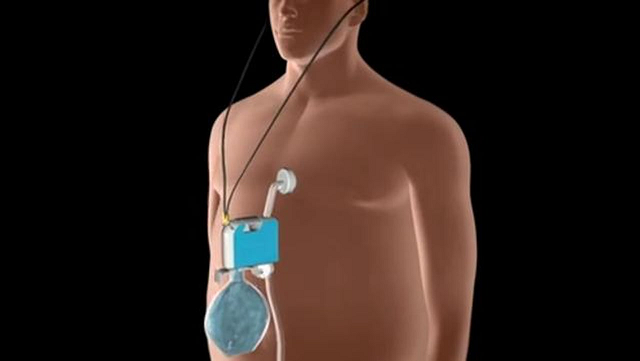Britons will be happy to know that a new weight loss device will be made available to them in a few months—and they don’t even have to worry about maintaining a diet for it to work.
Scroll down for video
[media-credit name=”benessere blog” link=”//www.benessereblog.it/” align=”aligncenter” width=”640″] [/media-credit]
[/media-credit]
The AspireAssist system claims to have helped hundreds of patients in the United States where they were able to lose up to 90 lbs of fat. However, critics aren’t too happy about the weight loss device, as it lets people binge-eat only to “vomit on demand,” which doesn’t really address the causes of obesity.
This weight loss system is said to put patients under a 15-minute operation to have a tube inserted through their abdomen and into their stomach. Once fitted, a small pump is attached at the tube’s exit, which then washes water into the stomach before the undigested food is sucked back into a bag.
[media-credit name=”Youtube” link=”//www.youtube.com” align=”aligncenter” width=”640″] [/media-credit]
[/media-credit]
[dfp1]
The procedure is repetitive. When not in use, the tube is left inside of the stomach and sealed with a special stopper. Patients who decide to use the weight loss device can avoid digesting as much as a third of the food they consume by pumping it out after each meal.
“No one needs to ever know,” the manufacturers said.
AspireAssist said that they advise careful chewing of food in their marketing materials in order to prevent blockage to the plastic tubes. British gastroenterologist Dr. Anthony Shonde said he is planning on offering the “excellent alternative to obesity surgery” to private patients in his clinic starting in September.
“Fitting and use [of the device] is not dangerous and the weight loss results are nearly as good as surgery—but without the risks,” he said.
[media-credit name=”Youtube” link=”//www.youtube.com” align=”aligncenter” width=”640″] [/media-credit]
[/media-credit]
Repulsive as it sounds, Dr. Shonde said that the principle is just “a reverse of PEG feeding, which we have used for more than 20 years to feed those too sick to take food by mouth.”
Tam Fry of the National Obesity Forum begs to differ, though, saying that the weight loss device is nothing more than “vomit on demand.”
[media-credit name=”Daily Mail” link=”//www.dailymail.co.uk/” align=”aligncenter” width=”640″] [/media-credit]
[/media-credit]
“I cannot believe we have now invented a gadget that allows people to make gluttons of themselves and eat like pigs and not suffer the consequences,” he said. “It appalls me to think people will be able to press a button to empty the contents of their stomachs. It is quite literally stomach-churning. It sends out every wrong signal in the book about healthy eating.”
[media-credit name=”vimeo” link=”//vimeo.com/” align=”aligncenter” width=”640″] [/media-credit]
[/media-credit]
[dfp2]
Still, the first British man to be fitted with the device said that AspireAssist changed his life. Sruli Saurymper, an IT consultant from Hendon, North London, said that he once weighed 142 kg and went on diets but ended up gaining more weight instead. When he found about the system, he flew to the Czech Republic for the 15-minute procedure to fit the stomach tube. The operation, together with the follow-up program, cost him nearly $3,000.
Saurymper lost almost 25 kg in 14 months, a result he is very happy about. He said, “It made losing the weight effortless. It’s done what no diet has done. It’s got my weight down and kept it down.”
[media-credit name=”aspirebariatrics” link=”//aspirebariatrics.com/” align=”aligncenter” width=”640″] [/media-credit]
[/media-credit]
[media-credit name=”Daily Mail” link=”//www.dailymail.co.uk/” align=”aligncenter” width=”640″] [/media-credit]
[/media-credit]
Geoffrey Blyth of Synmed, which was given the rights to sell AspireAssist in the UK, claimed that the product could save the NHS millions. The previous year, England spent about $37 million on obesity surgeries like stomach bypass operations that cost nearly $6,500 on average. This massive amount is also nearly triple the amount spent on anti-obesity campaigns.
Blyth explained, “We are talking to a number of NHS and private consultants in an attempt to get this method of weight loss established in the UK.”
A council member of the British Obesity and Metabolic Surgery Society (BOMSS), consultant surgeon James Byrne noted that the device is worth considering.
“I have some strong reservations, but given the rising number of people who are obese, it’s important to have an open mind about finding ways to help them,” he said.
Watch the video below
[video1]


